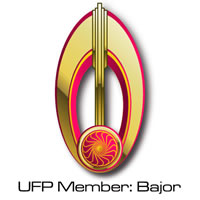 |
Bajoran
Logo |
Bajorans are a humanoid race from the planet Bajor. Bajorans are a very spiritual people, and their history has produced many great architects, artists, builders and philosophers.
Bajoran civilization has existed for over a half-million years. A contemplative and spiritual people, the early Bajorans saw little need in reaching to the stars. It is known, however, that the Bajoran people held limited interstellar abilities via primitive solar sail space craft.
Bajoran culture declined greatly during the Cardassian Occupation, from 2328 to 2369 (was formally annexed in 2339), during which time the Cardassian Union dominated the Bajoran people. 10 million Bajorans were killed, but despite the brutality of the government implemented massacres, freedom fighters in the mountains of Bajor never ceased their struggle for independence. The Cardassians made heavy use of forced labor camps and attempted to strip the Bajorans of their cultural identity. Cardassian strip mining of Bajor lead to planet-wide ecological devastation. It was the Cardassian Occupation of Bajor that forced the Bajoran people to throw off their strict caste based culture and actively fight against their oppressors. They have only recently been allowed to rebuild their culture.
The Bajoran people successfully repelled the Cardassians from their world in 2369 and a provisional government was established. The United Federation of Planets was called upon to provide assistance during this time of chaos and turbulence. The Federation assumed control of the abandoned Cardassian mining station Terok Nor (which the Federation renamed Deep Space Nine) and acted as a deterrent to future Cardassian reprisals against the Bajoran people.
The discovery of the Bajoran wormhole (which the Bajorans called the "Celestial Temple") made Bajor a site of scientific importance. Later, Bajor became a strategically important location when the Dominion began their invasion of the Alpha Quadrant.
Bajorans developed an intolerance of Cardassians due to the recent Cardassian occupation of Bajor. The Bajoran sense of spirituality is so strong that they have developed a very strong will due to their faith. Most Bajorans have studied their religion fairly extensively. Also, most Bajorans with a highly-developed faith are also devoted to the rebuilding of their world.
Alpha Quadrant. Is the third and largest of 8 planets orbiting Bajor - Ba'hava'el and is similar to Earth in most aspects. It possesses 5 moons and rotates by a 26-hour day.
The entire planet, or at least its largest continent, is known by geographic areas such as the Northwestern District, Northeastern District, etc. Those in turn, are divided into provinces such as Tozhat, Dahkur and Hedrickspool, each having its own administrative centre and council of Vedeks but both as subservient to the Capitol. The planet is larger than Terra and so its gravity is about 1.4g. A classical model of a Class M system, the planet has a number of large oceans breaking up the land mass, the water is said by many to be unusually green, probably due to a high concentration of microscopic plant life. The weather on Bajor is tropical over most of the planet, with periods of storms during certain seasons of the year. There are a number of desert areas, although most of the barren wasteland left by Cardassian mining has been reclaimed.
A massive system of aqueducts over the land mass provides both irrigation and an established transit system. Transport centres in major urban settlements often combine water and air transport, to the amusement of many off-world visitors.
The Capitol City is the center of Government, Military and Religion on Bajor. Most of the other settlements have now been fully rebuilt after the destruction of the Cardassian Withdrawal. There are few other large cities as Bajorans prefer small communities to large Urban sprawl.
Population:
17,525,000,000
Species Divisions:
Bajoran 89%; Non-Bajoran Humanoid 7%, Other 4%
Religion:
Bajoran 82%; other 5%; none 13%
Language:
Predominantly Bajoran, sizable minorities speaking Federation Standard,
smaller minorities speaking Kardassi, and Ferengi.
Labor Force:
7,360,500,000
Planetary Use:
Agricultural 12%; Inhabited 11%; Industrial 21%; Unused/Unusable 56%.
Capitol City:
Centre of government, military and religious organisations.
Location of the Central Bank and Temple of the Prophets.
Southern Islands:
Residences of many prominent people situated here.
Known for its fine Bajoran Wines and Sherry.
Ilvian Province:
Rural area used for farming, source of much of Bajor's staple foods.
Site of the Academy and Ilvian Medical Complex.
Bajoran Provisional Government was the ruling body set up following the withdrawal of the Cardassian Occupational forces. The splinter groups that formed the new government were brought into check by Kai Opaka following the discovery of the Celestial Temple by the Emissary. It is headed by the Chamber of Ministers, containing the most senior officials. Almost overthrown by the former Minister Jaro Essa in a coup supported by the Circle organisation. The ruling head of the government is the First Minister, who is elected by the public for a 6 year term.
The new government body is based on the Republic system that existed before the Occupation. A First Minister rules the Assembly of Ministers who have some jurisdiction over their own constituencies. The FM however has power of Veto over all government actions. The FM then has a layer of senior Ministers with specialist roles, who oversee major functions of the government. The Kai, the spiritual leader of Bajor, also has a seat of the Assembly but their power is mainly advisory to the actions of the senior Ministers and the FM. However due to the respected place of the Kai, many issues championed by them do tend to become law.
Full name:
The Bajoran Government
Type:
Republic
Administrative Divisions:
39 Provinces, 7 Colony worlds.
Independence:
August 6, 2369, from Cardassian Union
Legal System:
Based on traditional Bajoran law and interstellar law; Judicial review
of legislative acts.
Executive Branch:
First Minister
Legislative Branch:
Unicameral Chamber of Ministers
Judicial Branch:
Bajoran High Magistrate
Leaders: Chief of State and Head of
Government:
Asarem Wadeen (blonde female in her early thirties). Shaakar Edom was assassinated
in early 2380.
Suffrage:
Universal at age 17
Defense Forces:
Bajoran Militia
The Military is for the defence of the planet against outside and inside forces. It is based on an Army-type structure as opposed to the Navy-type ranking in Starfleet. The forces are lead by the Chief of Staff who reports directly to the Chamber of Ministers and is stationed near the Capitol City. Although small, the Bajoran Military is now well equipped thanks in part to Federation assistance. A number of old Runabout type vehicles have complimented the aerial forces of the Military. The Military uniform is a two-piece jump-suit, with broad shoulders that cover a short-sleeved undergarment. There is also a dress version that consists of a long coat that is gathered at the waist by a belt and sash. The colours represent the division that the officer serves, the belt / sash colour indicates where they serve.
Since obtaining full membership with the Federation, the Bajoran militia is now being integrated into Starfleet. Bajor still retains autonomy, but it is now an option for Militia forces to enter Starfleet as a career option without resistance. This is why you see so many Bajorans in Starfleet currently.
 |
An Antares-class sublight ship was used to mislead Cardassian forces into atacking what they believed was a group of Bajoran terrorists traveling from Valo I to Valo III in 2368. The ship was empty, but its destruction provided evidence that Admiral Kennelly had been colloborating with the Cardassians. Two Type-3 Galor-class ships destroy the Bajoran Antares-class Carrier in 2368. |
Antares-Class
Carrier |
|
 |
Sublight military spacecraft of Bajoran registry. Colonel Kira Nerys used several impulse ships in a blockade of the Romulan fleet in the Bajor system in 2375. |
Impulse
Ships |
|
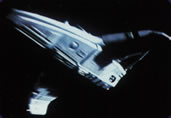 |
This is one of the sub-impulse fighters used by the Bajoran Resistance during the Cardassian Occupation of Bajor. Although these ships are substantially inferior to Cardassian vessels, the Bajorans still managed to annoy their brutal oppressors enough to achieve many missions. This ship is most effective in planetary atmospheres instead of space. Major Kira and Lieutenant Jadzia Dax used one of these to fight off Circle Forces on Bajor in 2370. |
Sub-Impulse
Fighters |
|
 |
The Bajoran Assault Ship was used almost exclusively in the fight with the Cardassians during the Occupation. They have also been used in the Circle seige of 2370, and recently in the Bajoran blockade of Derna against the Romulans by Colonel Kira in 2375. All in all, a good solid fighter, but hardly a match for most of the ships it is put up against. |
Assault
Vessel |
|
Kai - Overall leader of the Assembly and head of the faith.
Vedek - Member of the Assembly.
Prylar - Head of a shrine or meeting place.
Monk - Assistants to the Prylars and Vedeks.
Acolyte - Trainee, learning the disciplines of the faith.
Prophets
The Prophets are the central figures of the Bajoran faith, transcendent
entities who exist in a non-linear time frame. Bajoran faith believes the
Prophets to be the embodiment of truth, who reveals their wisdom through
visions given by the Orbs. The Prophets are also the ones who replenish
the life force of Bajorans, the 'Pagh' that allows existence.
The worship of the Prophets has a number of rituals, but these are mainly carried out by the Vedeks and other priests of the Order. Most Bajorans practice personal meditation daily at small shrines within their living quarters. A shrine usually consists of a round plaque with the emblem of the Prophets and a number of candles. The usual technique that has been passed down by the Vedeks for centuries is to stand in front of the shrine with your arms bent at right angles and pointing away from your body so that the palms of your hands face the plaque. The technique of divining the Pagh is an ancient ritual that is still carried out by many Vedeks although not as many as before as the practice has become rather old-fashioned with many distinguished Vedeks not performing the ritual. The procedure is for the Vedek to grasp the persons ear and sense the Pagh within, giving insight on the person and possibly future events.
Pah-wraiths
Energy-based lifeforms that lived in the Bajoran wormhole. Long ago, the
Pah-wraths were banished by the Prophets to the fire caves on planet
Bajor and forbidden to return. The Koss'moran is a Bajoran legend that
tells of false Prophets or Pah-wraiths who were cast out of the Bajoran
celestial temple. The Bajoran word Koss'moran comes from the verb kosst
that means to be, and amoran, which means banished.
Orbs (Tears of the Prophets)
Approximately 10,000 years ago. The first Orb, with eight others to follow,
appeared in the skies of Bajor. Taken as a gift from the Prophets to
endow their followers with wisdom and insight, the Orbs were traditionally
housed in sacred shrines at temples and monasteries around Bajor. Each
Orb has a different function. After the Occupation, only one from the
original nine Orbs remained. Through the years, the rest were recovered
and are currently in the hands of the Bajoran people. The nine Orbs are:
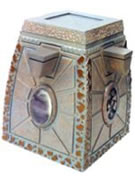 Orb Casing |
Orb of Time Returned by Cardassian government in 2373. |
| Orb of Contemplation Destroyed by Dukat in 2374. |
|
| Orb of the Emissary Vanished after fullfilling its purpose in 2375. |
|
| Orb of Souls Found in an Obsidian Order vault. |
|
| Orb of Memory: Green energy form. It places the user into a vivid distant memory. |
|
| The Orb of Wisdom: Pink energy form. Grand Nagus Zek was responsible for the restoration of this Orb to Bajorans in 2371. It forces overseen knowledge into the user's attention. |
|
| Orb of Prophecy and Change Blue energy form. It presents the user with a surrealist projection of the future, open to interpretation but usually correct in some way. |
|
| Orb of Truth Found in an Obsidian Order vault. |
|
| Orb of the Emissary Vanished in 2375 after Ben Sisko used it to re-open the Celestial Temple. |
Emissary
The title given to the person who would discover the Celestial Temple and
speak with the Prophets, then unify the Bajoran people. Kai Opaka announced
Commander Benjamin Sisko was the Emissary when he had just arrived at
the Station. Akorem Laan briefly succeeded Sisko as the Emissary in 2372
when the Prophets transported him two centuries from his lifetime into
the 24nd century. After reinstating the unpopular D'jarra caste system,
Sisko challenged Akorem, and was ultimately vindicated by the Prophets
themselves. Captain Sisko is now firmly established as the Emissary of
Bajor. The one upon whom the hopes of a whole world fall.
A new religion based on the Ohalu prophecies. Discovered in the temples of B'Hala, the prophecies are a hundred percent accurate. The Prophets are not gods. They are Siblings. Teachers. Guardian Angels. Ohalu prophesized the return of a Herald which would precede the birth of the Avatar, the second child of the Emissary. This apparently came true as Jake Sisko returned shortly before Ben Sisko's second child was born.
Gratitude Festival
The most important annual religious holiday is the Gratitude Festival.
During which people burn Renewal Scrolls in ceremonial fires that symbolically
wash away the problems written on the scrolls. As well as being enjoyed
by Bajorans, many foreigners now travel to the Bajoran system for the
festival which has gone from strength to strength in the past few years
with its organised events and displays. Although some extremist orders
resent the intrusion of outsiders into our celebrations they have found
it hard to overcome the reality of the increased trade for the duration
of the festival. The ceremonial greeting of "Peldar Joy" has
become widely known in other races who have never been known to speak
Bajoran before.
Days of Atonement
Modern Bajoran holiday where Bajorans remember the Cardassian
Occupation and atone for the actions they did during that dark period.
Time of Cleansing
Month long ritual when all faithful Bajorans abstain
from the pleasures of life.
Ha'mara
Holiday held on the anniversary of the Emissary's arrival.
A day of fasting following a festival of lights the night before.
 |
The Bajoran representation of the Phoenician alphabet. |
There are a wide number of local dialects on Bajor, as well as a number of archaic dialects used only by the Vedeks in religious ceremonies. That said only one common version is used in everyday speech. The Bajoran language is quite old and has changed very little in the past 400 years. Although all Bajorans do speak it, with the large amount of outside contact we now have, most also speak Federation Standard. Standard is now also taught in all Bajoran schools on a level with the native Bajoran.
Bajorans fit the general humanoid pattern very well. By far the most obvious difference is the small ridge where the nose meets the brow, although many races have similar, the Bajoran look is quite unique and characteristic. Bajoran life span is now increasing following the harsh times of the Occupation where life expectancy plummeted to 78 years. It is presently quoted by the Bajoran Medical Council as 137 years, but people of 165 years and over have been reported in Bajoran history.
The Bajoran body is slightly more sturdy than Terrans due to a more developed bone structure, especially the spine which is a weak point in Terran anatomy. It is much more difficult for example for a Bajoran to break his neck leading to death than a Terran. Ancient historical texts shows that in Hand- to-Hand combat puncturing the opponents heart by penetrating the chest cavity was the easiest method to ensure death.
Due to the Occupation, Medical research was very much stopped. Many Sects worked on Genetics in order to create better plants to feed the refugees, but also sadly to develop Biological weapons to use against the Cardassians. During a purge of underground laboratories on Bajor, many leading Geneticists were killed by the Cardassians. Now the Federation has brought its much needed advanced Medical knowledge to the planet.
Their heart's internal arrangement is mirrored along a horizontal, not vertical axis; puncturing the lower ventricle of the heart brings immediate death.
Bajoran women carry their children for less than five months. Because they have a relatively short gestation period, they vascularize very quickly. Mother and child form a complex interconnecting network of bloodvessels. Bajoran women often have fits of uncontrollable sneezing while pregnant. This an annoying but non-life threatening condition for which there is no cure. Pregnant women also have a tendency towards swollen ankles, a trait shared with Terran women. The traditional treatment for this is takeo herb. Another treatment is makara herbs, which help keep up progesterone levels. However, these have an unappealing taste and counteract the effects of sedatives.
Childbirth
The traditional approach to labour and delivery reflects the strong spiritual
beliefs. A birthing room is typically furnished with piles of pillows
instead of furniture, and the walls are covered with tapestries. The
room contains a small shrine with constantly burning incense. The mother-to-be
is attended by a midwife who wears traditional robes and guides the woman
and her supporters through the process.
Traditional Bajoran childbirth requires the mother to achieve a completely relaxed state through breathing exercises, ritual music and incense. Members of the womans family or close friends help to play the rhythmic music that helps to create the necessary environment.
The rhythm must be constant so that she can enter a state of deep relaxation, which is the only way a Bajoran woman can give birth. If all goes well labour and delivery usually only takes an hour. The birth doesn't involve any pain. During labour, Bajoran women produce high levels of pain-surpressing endorphins. When a woman is unable to fully relax, her body stops producing these endorphins. If this happens the labour process stops entirely. It could be days or weeks before the labour process starts again. When the child arrives, all present verbally welcome the child into the world.
"Awake child, we await you with love and welcome you into the world."
Earrings
The wearing of silver earrings is a direct link to the belief in the Pagh,
or life force, that can be sensed by the Monks through the ear. Many
scientists have taken to not wearing an earring in a break from traditions,
they have developed doubts in the Pagh belief even though its predictions
are very accurate most of the time. Every Bajoran wearing an earring
has a unique design that can link it to the person. Often a characteristic
effect or insignia is carried down through the generations of a family.
The identity of Bajorans is intrinsically connected to their earring. The design is often deeply connected to family lineage and the archaic d'jarra, but some religious figures and Militia officers are known to change their earrings to better adapt to their line of work. The earring is most often worn on the right ear, and is usually diamide-laced birithium in substance.
Death Chant
The Death Chant is a mourning song that is to commemorate and pay respect
to people that have died. The entire song lasts over 3 hours and many
off-worlders find it boring due to what they call excessive length. But,
since we are mourning the death of a loved one 3 hours does not seem
unreasonable to most Bajorans, making this a tradition that is likely
to continue for a long time yet.
Bajorans hold that a deceased soul should make peace with its former life and bid goodbye to those left behind before proceeding on to the afterlife.
Rite of Separation
When two Bajorans wish to end a close romantic relationship they undergo
the Bajoran Rite of Separation. This is seen in 2373 between Starfleet
doctor Julian Bashir and the Bajoran woman Leeta in [DS9: Let He Who
Is Without Sin] and was performed on the leisure planet Risa. The Rite
involves the couple spending several days celebrating their parting.
When done correctly, the Rite of Separation allows for a friendly parting
with no hurt feelings or recriminations.
Throughout the 30 years of the Occupation, the underground resistance relentlessly bombed and sabotaged Cardassia's organized government, knowing full well the Cardassians would retaliate with three times the ferocity. Resistance cells such as the Shakaar, the Higa Metar, the Khon-Ma and the Ornathia cells engaged the Cardassians in guerrilla warfare in the mountains of Bajor, and despite their vastly inferior numbers, somehow always managed to escape Cardassian pursuit. Though millions died during the Occupation, the violent opposition to Cardassian rule finally made the decision-makers back on Cardassia Prime change their stance on Bajor.
In 2369, the Bajor-Cardassia Armistice was signed, and Cardassian Supreme Directive 26/45 issued, which provided for the full retreat of Cardassian presence from Bajor. After some initial chaos and anarchy, the newly erected Bajoran Provisional Government signed the Ilvian Proclamation that exiled all and any person who had collaborated with the Occupation's Cardassian forces.
Though free at last from the authoritarian rule of Cardassia, the world of Bajor was left shattered. Defenseless and struggling to recover from the decades of war and deprivation, the Bajoran provisional government requested the Federation to administer to the operations of Terok Nor, abandoned after the hasty withdrawal. Designated as space station Deep Space Nine by Starfleet, Commander Benjamin Sisko arrived on board with his senior officers to help oversee the rebuilding of Bajor and restore the station to working order. Cardassian policy dictates that anything of value which cannot be taken must be sabotaged or rendered useless and Terok Nor was accordingly trashed by the Cardassians before they left it to the Bajorans.
Many Bajorans have joined Starfleet despite their home planet of Bajor still being in recovery from the Cardassian occupation, while others prefer to work with the Federation from within the Bajoran system.
500 millennia ago Bajor was already a flourishing civilization, culturally rich and technologically advanced. Their faith gave the people the peace and harmony of life while fostering the philosophers, architects, and builders that are the pride of Bajoran culture.
10,000 years ago, the first of nine Orbs fell from the sky, and the present Bajoran faith was founded on the wisdom imparted from Orb-generated visions. In between these ancient times and the 22nd century, Bajoran explorers would travel through near-space with their tachyon accelerated space vessels, coming in contact with nearby Cardassia, whose people were then as peaceful and religious as themselves.
The ancient Bajorans used lightships powered by solar sails to accurately chart the sector. Most of the inhabitable planets within the system and in neighbouring systems have been colonised at some stage in the past. Few of these colonies now survive, except on some of the Bajoran moons and remnants of settlement camps in near-by systems that were neutral space during the Occupation. One of the most established colonies still surviving is Prophets Landing which is situated near to the Cardassian Border. The colony of New Bajor which was set up in the Gamma Quadrant, was wiped out by the Jem'Hadar with the loss of hundreds of Bajoran lives. Since then no Bajoran colonisation attempts have been made in the Gamma Quadrant and a tentative agreement has been made with the Dominion to reduce the likelihood of attack.
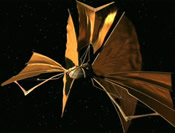 |
Spacecraft used by ancient Bajorans, propelled by light pressure from Bajor's sun. Solair-sail vessels, also known as light-ships, had no impulse reaction or warp propulsion system, but rather had enormous reflective sails that caught the tenuous solar wind. Crew accommodations were minimal in order to conserve mass. Such ships were used eight centuries ago to explore the Bajor system. Some ancient solar sailers even reached Cardassia. Until recently, Cardassian scholars scoffed at the suggestion that Bajorans crossed instellar space so long ago, but such transit was demonstrated in 2371 by Benjamin Sisko, who built a solar sailer from ancient plans. Sisko's craft was caught by tachyon eddies in the Denorios Belt, sweeping it at faster-than-light speeds to Cardassia. Shortly after Sisko's arrival, Cardassian archaeologists reported they had found ancient wreckage of such a ship on Cardassia. |
Thousands of years passed. Cardassia Prime became a starved planet that was beset by problems caused by its lack of natural resources. When the military, sickened by the weakness of its civilian government, seized control of the state, they believed that only expansion will allow Cardassians to survive. Ruthless conquest of nearby systems followed, and the Empire lost no time in plotting to annex neighboring Bajor.
D'jarra Caste
Ancient Bajorans lived their lives according to the d'jarra caste system.
A Bajoran's social status and vocation was dictated by the d'jarra at
birth and usually indicated in part within the design of the earring.
Passed on for generations, the system was abandoned during the Occupation,
when every Bajoran became subservient of the Cardassians.
 Captain Kira |
 Leeta |
 Li Nalas |
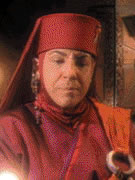 Kai Opaka |
 Ro Laren |
 Shaakar Edom |
 Vedek Bareil |
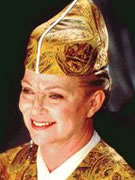 Kai Winn |
 Sito Jaxa |
 Akorem Laan |
 Jaro Essa |
 Bajoran Earring |
2. Startrek.com
3. The Shaakar Website (defunct)
4. Bajoran Religion, Prayers, Cultures, Rituals. Can also find terminologies used for various clothing items, etc.